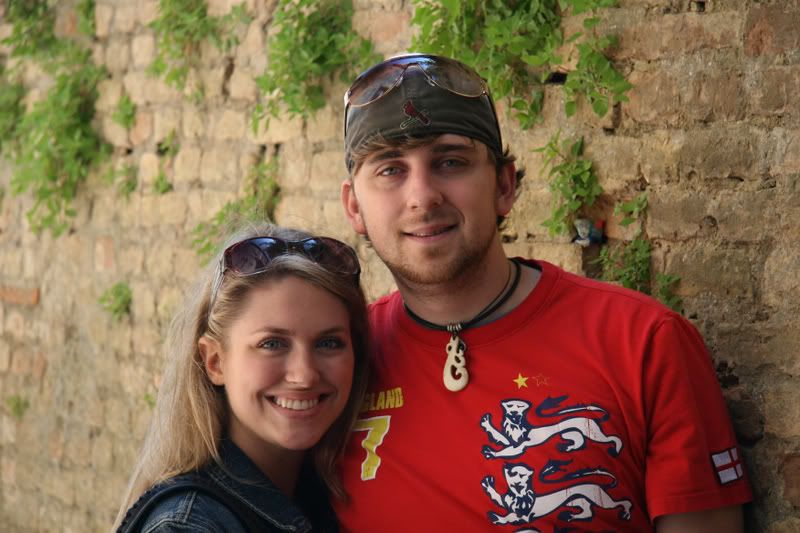This morning we awoke to the usual sound of the workers working outside on our apartment walls. For the past couple of weeks they have been striping off all of the concrete stucco on the outside wall where our terrace is. We've had a problem with leaks (resulting in mold growing on our walls) in our bedroom and bathroom. They finally have all the stucco off (thankfully, no more jackhammers and drilling) and due to no insulation our house has been really cold the past 2 weeks. But thankfully they're getting this all done before the baby arrives. They will hopefully repaint our bedroom and bathroom for us as well. Yesterday they put a new exterior door leading to the terrace. When we have a downpour, water leaks through the 2 sets of doors and down our hallway. Our landlord was thinking about building a large sunroom off of the door or even an awning, but our terrace isn't level enough for that (bummer, I was really hoping for a sunroom). But as the alarm went off this morning and Brandon and I laid in bed trying to convince each other to get up when I heard one of the workers call a man "pinocchio"! They really do have people here with the name pinochio! Brandon said it has to be a nickname, but I heard what was said! Also, since the scaffolding, they use to lift materials from the ground floor, is infront of our window I awoke to one of them singing to me. Our blinds are closed, but it was funny hearing him sing some type of english pop song while working. It was like he was in his own little world.
Moving on, we have a new sister in christ, Valerie! It was a private baptism. She's a very shy girl and she only wanted her parents and boyfriend. Her parents are members of the church and her dad is a carabinieri (special police force) that deals with the mafia.
Brandon and Stephano met yesterday with 2 ladies (and a son) of the Jehovah's witnesses. One lady has been a member for 20 years and the other for about 6 months. They came together to discuss the book of Matthew. Brandon said the discussion went very well and I'll see if he can write more about it on here. He is out this morning with Stephano distributing flyers around several colleges for english lessons.
Tonight we have an english lesson with Georgia and later on this evening we are getting the congregation together play some english learning games and to start teaching them the 4 part harmonies of hymns as many of them didn't grow up hearing 4 part harmonies like we have in the states.
Tuesday, February 12, 2008
An italian singing to me outside my window.
Posted by The Edwards at 1:48 AM 0 comments
Thursday, February 7, 2008
a crazy week
Well, Brandon did a good job explaining the history behind St. Agatha's day, but let me explain to you what it's really like on the grounds. There has been a week of non-stop fireworks. And we thought New Year's was bad, oh no, this is much worst. Around 6:00 pm fireworks start going off on the hour, every hour, till about midnight. If you've ever seen a firework show at Disney World or Washington D.C., times that show by 50 and you get a Catania firework show. This lasted about a week. It was nice a first because we can watch the whole show from inside through our living room windows, but at the end of every show they shoot off a type of "onion bomb". All you see is a small blink of light, about a size of a star, but then out of nowhere comes this great sounding "BOOM" like a loud cannon being shot off. It's so loud that the glass in our windows shake. This happens at the end of every firework show for the last 5 minutes. Then as it got closer to St. Agatha's shining day, they would shoot off fireworks at 2am on Saturday, Sunday, Monday, and Tuesday!!! Not only that, but those lovely "onion bombs" that seem to be their favorite, went off at 4am those 4 days!! 4AM!!!! Then at 6am the church bells start going off like it's a war zone and telling everyone to run for shelter but really it's "rejoicing for St. Agatha" and calling everyone to Mass for Tuesday morning. Thankfully, now, we have had much quiet mornings.
On a side note, Brandon has been a wonderful husband with getting all of our insurance and doctor's appointments straightened out. After several visits to many offices and waiting in lines for hours, we now have everything taken care of. The baby is doing good. Momma is "feeling" the first signs of morning sickness but no actions have been partaken...."yet".
Posted by The Edwards at 12:29 AM 0 comments
Tuesday, February 5, 2008
Three days of cult, devotion, folklore, and tradition, that stand almost alone in the world.
Only the Holy Week in Seville, and the corpus Domini ceremony in Cuzco, Peru, may be compared in terms of popularity, to the festivities that since five centuries bave immutably been held in St. Agatha's honour. For three days, Catanians and tourists swarm in the streets, numbering to almost a million. During those intense days, Catania turns into one and only crowd marching behind the Patron.
( Three incredible days )
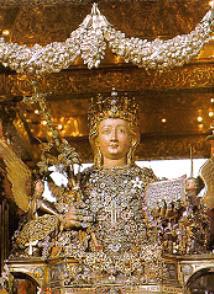 The 4th and 5th of February stand out among the three days of festivities, when St. Agatha passes through then eigh bourhoods on her silver carriage (Catanians call it, specifically, "fercolo" or, more commonly, "vara").
The 4th and 5th of February stand out among the three days of festivities, when St. Agatha passes through then eigh bourhoods on her silver carriage (Catanians call it, specifically, "fercolo" or, more commonly, "vara").
The first day of celebration, the 3th of February, develops itself into three distinct moments: the long and solemn Midday procession for "the offering of wax" to which civil, religious and militar authorities all attend bearing the standards of the City, the Province, and the University. Leaving St. Agatha' s (the Church of St. Agata alla Fornace ) to the Cathedral, the procession cuts through two lines of a huge crowd. Eleven "candelore" (large candleshaped structures), symbolizing the guilds, and two carriages belonging to the old Catanian Senate, bring up the rear. In the afternoon, at 3.00 PM, St. Agatha's international cross-country race takes place through the old and new streets of the town-centre. Finally, in the evening, later than 8.00 PM, grandious fireworks are on display in piazza Duomo.
 The following night is spent sleepless by tbousands of Catanians, who crowd the Cathedral at dawn in a strongly emotional atmosphere, for a first meeting with "their" Saint. St. Agatha's image, waving amidst the crowd, is firstly brought to the high altar, than on the "vara" by devotees wearing the "sacco" (a white alb): its bust, covered up with jewels bestowed by sovereigns and celebrities (there also is a cross wbich was donated by composer Vincenzo Bellini), rises and falls amidst a cheering crowd.
The following night is spent sleepless by tbousands of Catanians, who crowd the Cathedral at dawn in a strongly emotional atmosphere, for a first meeting with "their" Saint. St. Agatha's image, waving amidst the crowd, is firstly brought to the high altar, than on the "vara" by devotees wearing the "sacco" (a white alb): its bust, covered up with jewels bestowed by sovereigns and celebrities (there also is a cross wbich was donated by composer Vincenzo Bellini), rises and falls amidst a cheering crowd.
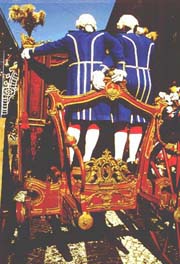 The carriage carrying the reliquary-bust and the finely wrought silver casket containing other relics, starts covering the route crossing through Porta Uzeda, then passing through via Dusmet, the distinctive feature of which are the arches holding up the railway: beneath them, once there was the sea, just close to via Biscari, where St. Agatha supposedly was born. The route from piazza Carlo Alberto to piazza Stesicoro is eagerly awaited: we are now in places tbat are extremely dear to Catanians; in these ancient sites, Agatha men with imprisonment and martyrdom, dying in atrocious sufferings. There, it is anotber spectacular moment: thousands of devotes run and drag the heavy carriage along a slope (salita dei Cappuccini), stopping once halfway to pay homage to the Sacred Gaol.
The carriage carrying the reliquary-bust and the finely wrought silver casket containing other relics, starts covering the route crossing through Porta Uzeda, then passing through via Dusmet, the distinctive feature of which are the arches holding up the railway: beneath them, once there was the sea, just close to via Biscari, where St. Agatha supposedly was born. The route from piazza Carlo Alberto to piazza Stesicoro is eagerly awaited: we are now in places tbat are extremely dear to Catanians; in these ancient sites, Agatha men with imprisonment and martyrdom, dying in atrocious sufferings. There, it is anotber spectacular moment: thousands of devotes run and drag the heavy carriage along a slope (salita dei Cappuccini), stopping once halfway to pay homage to the Sacred Gaol.
 In the evening, the run takes place downtown: via Plebiscito, Fortino, S. Cristoforo. There the festivities are felt in a different way: all private houses are open and well-lit, coffee-houses are crowded all night long. Music is heard coming from everywhere, Streets are crowded with stalls and booths where all sorts of sweets are sold, and mobile grids where horse meat is roasted. Balconies are well-lit, kiosks are strewn with flowers and embellisbed with St. Agatha's effigy, while shop-windows display artistic reproductions of the "candelore". Almost at dawn, magnificent fireworks welcome the Saint on her way back to the Cathedral passing through Porta Uzeda again.
In the evening, the run takes place downtown: via Plebiscito, Fortino, S. Cristoforo. There the festivities are felt in a different way: all private houses are open and well-lit, coffee-houses are crowded all night long. Music is heard coming from everywhere, Streets are crowded with stalls and booths where all sorts of sweets are sold, and mobile grids where horse meat is roasted. Balconies are well-lit, kiosks are strewn with flowers and embellisbed with St. Agatha's effigy, while shop-windows display artistic reproductions of the "candelore". Almost at dawn, magnificent fireworks welcome the Saint on her way back to the Cathedral passing through Porta Uzeda again.
( Spectacle and devotion )
Just few hours of sleep: in the late morning of the 5th. of February (the climax of the festivity), a Pontifical Mass is celebrated by a specially invited prelate.
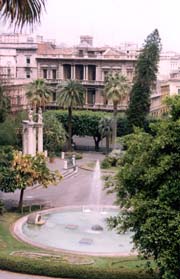 The Saint's image travels along another route, through the old town centre: the carriage proceeds slowly along the elegant via Etnea. The eleven, richly adorned "candelore" lead the procession, being followed by 700 devotees holding torches: then the white river of devotees follows. They all drag the "vara" and sing the praises of the Patron ("We are all, all devotees. Citizens, long live St. Agatha!"). The City bell tolls, announcing the Mayor's homage to the Saint. The stream of people puts on a protracted and fascinating tableau vivant. In the evening, people crowd together again in piazza Borgo, in order to attend further fireworks (also known as "the fireworks of the evening of three"); soon after the crowd follows and escorts the "candelore" in an "endurance race" along the slope of "salita di San Giuliano". Time goes by, and the setting sun gives way to the night: St. Agatha patiently awaits for the end of the contest, at the crossing of via Etnea and via di San Giuliano: it's the "final pull", that should bring the festivity to an end, with an enthusiastic applause of relief. The race is an event mostly reserved to young people: strong arms and sturdy legs are needed to drag the several tons of the "vara". Partaking to the race is a mark of love and devotion that should non be underrated: doing it in "one go" allows to draw favorable auspicies for the year, since the real New Years Day in Catania falls on the 5th of February; once, contracts and deeds were actually started or delivered on such a date.
The Saint's image travels along another route, through the old town centre: the carriage proceeds slowly along the elegant via Etnea. The eleven, richly adorned "candelore" lead the procession, being followed by 700 devotees holding torches: then the white river of devotees follows. They all drag the "vara" and sing the praises of the Patron ("We are all, all devotees. Citizens, long live St. Agatha!"). The City bell tolls, announcing the Mayor's homage to the Saint. The stream of people puts on a protracted and fascinating tableau vivant. In the evening, people crowd together again in piazza Borgo, in order to attend further fireworks (also known as "the fireworks of the evening of three"); soon after the crowd follows and escorts the "candelore" in an "endurance race" along the slope of "salita di San Giuliano". Time goes by, and the setting sun gives way to the night: St. Agatha patiently awaits for the end of the contest, at the crossing of via Etnea and via di San Giuliano: it's the "final pull", that should bring the festivity to an end, with an enthusiastic applause of relief. The race is an event mostly reserved to young people: strong arms and sturdy legs are needed to drag the several tons of the "vara". Partaking to the race is a mark of love and devotion that should non be underrated: doing it in "one go" allows to draw favorable auspicies for the year, since the real New Years Day in Catania falls on the 5th of February; once, contracts and deeds were actually started or delivered on such a date.
( Martyrdom and the old town )
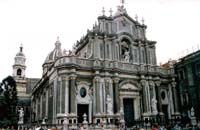 Catania, brought back to life after every eruption of the Etna volcano, has bestowed some of the most beautiful churches and monuments to the Patron. On the inside of "S. Agata al Carcere", the III century remains of the gaol, where St. Agatha faced her martyrdom and death, are still to be seen. The Church of "S. Agata alla Fornace" (in piazza stesicoro) and "S. Agata la Vetere" (the first Cathedral of Catania, and supposedly the first burial-place of the Saint) are non far. Many other places in Catania keep alive the memory of St. Agatha: "Badia S. Agata", the "stele" in piazza dei Martiri, the fountain in via Dusmet, the Norman-baroque Cathedral.
Catania, brought back to life after every eruption of the Etna volcano, has bestowed some of the most beautiful churches and monuments to the Patron. On the inside of "S. Agata al Carcere", the III century remains of the gaol, where St. Agatha faced her martyrdom and death, are still to be seen. The Church of "S. Agata alla Fornace" (in piazza stesicoro) and "S. Agata la Vetere" (the first Cathedral of Catania, and supposedly the first burial-place of the Saint) are non far. Many other places in Catania keep alive the memory of St. Agatha: "Badia S. Agata", the "stele" in piazza dei Martiri, the fountain in via Dusmet, the Norman-baroque Cathedral.
Precious relics, as such as the bust and the casket bearing the signature of Di Bartolo, are preserved in the Basilica, but the real centre of the cult of St. Agatha is the Church of the Sacred Gaol. On the inside, besides the dark cell where the Saint was imprisoned, a lavic slabbearing St. Agatha's footprints can be seen. The prison, an embankment, was part of the buildings of the Roman praetorium, close to the residence of Quintianus, Agatha's persecutor. Upon the high altar, a large panel dating back to 1588 and bearing Bernardino Niger's signature, portras St. Agatha at the stake. Next to the Gaol, a highly revered lavic stone bears St. Agatha's footprints. A plaque of the XV century and portraying St. Agatha can be seen in the sacristy, besides memorial stones, bas-reliefs and an old epigraph: "Noli offendere patriam Aghatae, quia ultrix iniuratum est" (Do not offend Agatha's nation, "cause she will avenge all offence).
( Candlemas, a baroque feast )
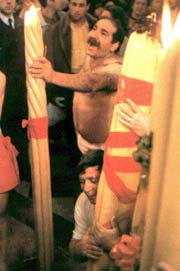
"Almost all Sicilian feasts are baroque" says historian Giovanni Lanzafame. Writing about the eleven "candelore", he defines the so called "annacata " as "baroque on the move ". Baroque moving through a baroque city as devised by Vaccarini after the 1693 earthquake.
Ten huge "candelore" and a smaller one, now lead the procession. A candelabrum in memory of cardinal Ventimiglia comes first, being followed by the "candelora" (decorated with four griffins at the basement) offered by the inhabitants of San Giuseppe La Rena. Then the candelabrum of the Floriculturists follows, in Gothic style, portraying statues of Catanian martyrs and bishops: once it was tooped with a bouquet of flowers, now replaced by a bow.
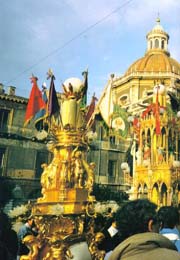 The "candelora " representing Fishmongers comes next: it is in rococo style and bears votive offerings and a statue of St. Francis of Paola, patron of fisbermen and sailors. The other "candelore" represent Greengrocers (it bears a bust of St. Agatha), Butchers (it displays a small bouquet of flowers), Makers of Pasta (an eighteenth-century candlestick), Grocers (in liberty style, decorated with characteristic caryatids at the basement), Bakers (the heaviest, carried by twelve people, instead of eight, and displaying human-heigbt statues of angels), Vintners (carried by ten people and displaying four lions and griffins at the basement).
The "candelora " representing Fishmongers comes next: it is in rococo style and bears votive offerings and a statue of St. Francis of Paola, patron of fisbermen and sailors. The other "candelore" represent Greengrocers (it bears a bust of St. Agatha), Butchers (it displays a small bouquet of flowers), Makers of Pasta (an eighteenth-century candlestick), Grocers (in liberty style, decorated with characteristic caryatids at the basement), Bakers (the heaviest, carried by twelve people, instead of eight, and displaying human-heigbt statues of angels), Vintners (carried by ten people and displaying four lions and griffins at the basement).
( An international cult )
The cult of St. Agatha is non strictly Catanian: the Saint is venerated all over the world. St. Agatha is the Patron of 44 italian municipalities, and 14 of them bear her name. Besides, St. Agatha is among the Patrons of Malta and S. Marino. In Spain, she is worshipped in Andalucia and in Jèria (Valencia). The chapel in Barcelona where the Catholic sovereigns welcomed Christopher Columbus back from his first trip to America, is dedicated to St. Agatha. A peculiar tradition takes place in Zamarramal (Segovia): on the 5th of February, women are the masters of the city. In Portugal, St. Agatha is the Patron of Agueda. In Germany Agatha is the Patron of Aschaffemburg. In France, St. Agatha is venerated in Le Fournet (Normandy). The cult was grandiosely celebrated in Costantinople, while in Greece the Saint is extremely popular, specially in the Aetolian region. Even in India, in Viayawala, a cult of St. Agatha exists, and in Argentina, where sbe is the Patron of firemen. The cult is widely spread in Italy, specially in Lombardia, but also in Rome, Florence and Naples.
Posted by The Edwards at 9:23 AM 0 comments
